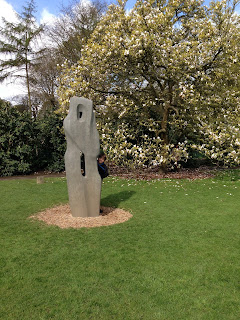Feels good, but it has taken forever and has required several ritual burnings, but the eldest son always loves a bonfire!
Boundary fencing has had to be put up, along an access track between the campsite paddock and our long field.
Hay and feed bins have been moved to a lovely little haystore and new gateways have been made.
So,the horses have been in cropping the grass in the campsite paddock and the men folk have been mowing and raking today.
Our inherited heaps of 'SWW surplus' in the area that has been 'under management' since we opened, four years ago, has now been managed! The additional usable space now houses a small hay and feed store.
Next to the hay store is a grassy knoll to picnic on and a reclaimed timber sleeper provides a late afternoon spot to sit and feel the last of the sun's rays on your face.
Bloggers who have camped with us will not be surprised to hear that as always on Ashfarm, we are a work in progress, so although the three lovely tree ferns - now known as the Three Sisters (Jimmie, Susie and Gloria, though which is which I have not yet decided) - seem to be adapting to life in Cornwall and being transplanted from their pots into the ground
and the view from the compost loo is now even prettier, elsewhere in the reservoir garden, beds and plants have been sadly neglected since spring arrived.
So campers, please forgive the weeds growing amongst the flower and succulent beds, I will endeavour to bring it a little more under control as summer progresses, whilst allowing nature's mix of pink campions and blue bells to continue their own pretty display.
Despite all this work going on, my youngest son and I managed to squeeze in a little recreation. During our trip to collect the tree ferns we took in Alexandra Palace in London for a dog walk .....
..and tracked down some culture in the form of a Barbara Hepworth sculpture in the grounds of Kenwood House on Hampstead Heath, ironic it was admired by a St Ives schoolboy and almost outdone by a beautiful magnolia, which also do so well in Cornwall.
Barbara Hepworth moved to St. Ives in 1939 in order to escape a panicked London shortly before the declaration of the Second World War. Although her arrival was not auspicious, Hepworth admired the ‘barbaric and magical countryside’ of Cornwall, studded with ancient standing stones and hemmed by dramatic coastal landscapes. Thirty years later, and towards the end of her life, Hepworth declared the area her ‘spiritual home’.
On Hampstead Heath, something of the totemic phenomena of the Cornish landscape has been enshrined among the rhododendron bushes beside Kenwood House. Hepworth’s Monolith Empyrean (meaning ‘heavenly stone’) is carved from a limestone block rich with fossils. The sculpture’s outline is humanoid, but the viewer is invited to look through and beyond the sculpture by cavities that pierce right through the block, framing shifting perspectives of the gardens.



















No comments:
Post a Comment